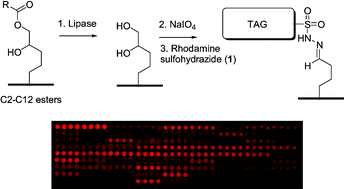A red-fluorescent substrate microarray for lipase fingerprinting†
Abstract
A lipase substrate microarray was obtained by printing aliphatic C2–C12 monoesters of (5R)- and (5S)-3-(5,6-dihydroxyhexyloxy)benzaldehyde by reductive alkylation on amine-functionalized glass slides coated with bovine serum albumin and a short PEG linker. The microarray features 12 substrates and their 66 possible binary mixtures spotted in a 9 × 36 spot array. Lipase reactions are detected by chemoselective NaIO4-oxidation of the 1,2-diol hydrolysis product to form an aldehyde, which is then tagged with the red-fluorescent dye rhodamine B sulfohydrazide 1. Specific fingerprints are produced by active enzymes. These experiments provide the first example of lipase fingerprinting using microarrays.


 Please wait while we load your content...
Please wait while we load your content...